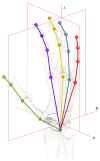Clinically Informed Automated Assessment of Finger Tapping Videos in Parkinson's Disease
- PMID: 38005535
- PMCID: PMC10674854
- DOI: 10.3390/s23229149
Clinically Informed Automated Assessment of Finger Tapping Videos in Parkinson's Disease
Abstract
The utilization of Artificial Intelligence (AI) for assessing motor performance in Parkinson's Disease (PD) offers substantial potential, particularly if the results can be integrated into clinical decision-making processes. However, the precise quantification of PD symptoms remains a persistent challenge. The current standard Unified Parkinson's Disease Rating Scale (UPDRS) and its variations serve as the primary clinical tools for evaluating motor symptoms in PD, but are time-intensive and prone to inter-rater variability. Recent work has applied data-driven machine learning techniques to analyze videos of PD patients performing motor tasks, such as finger tapping, a UPDRS task to assess bradykinesia. However, these methods often use abstract features that are not closely related to clinical experience. In this paper, we introduce a customized machine learning approach for the automated scoring of UPDRS bradykinesia using single-view RGB videos of finger tapping, based on the extraction of detailed features that rigorously conform to the established UPDRS guidelines. We applied the method to 75 videos from 50 PD patients collected in both a laboratory and a realistic clinic environment. The classification performance agreed well with expert assessors, and the features selected by the Decision Tree aligned with clinical knowledge. Our proposed framework was designed to remain relevant amid ongoing patient recruitment and technological progress. The proposed approach incorporates features that closely resonate with clinical reasoning and shows promise for clinical implementation in the foreseeable future.
Keywords: Parkinson’s disease; UDPRS quantification; data-driven; finger tapping; machine learning.
Conflict of interest statement
The authors declare no conflict of interest.
Figures









Similar articles
-
A First Methodological Development and Validation of ReTap: An Open-Source UPDRS Finger Tapping Assessment Tool Based on Accelerometer-Data.Sensors (Basel). 2023 May 31;23(11):5238. doi: 10.3390/s23115238. Sensors (Basel). 2023. PMID: 37299968 Free PMC article.
-
The discerning eye of computer vision: Can it measure Parkinson's finger tap bradykinesia?J Neurol Sci. 2020 Sep 15;416:117003. doi: 10.1016/j.jns.2020.117003. Epub 2020 Jun 30. J Neurol Sci. 2020. PMID: 32645513
-
Supervised classification of bradykinesia in Parkinson's disease from smartphone videos.Artif Intell Med. 2020 Nov;110:101966. doi: 10.1016/j.artmed.2020.101966. Epub 2020 Oct 6. Artif Intell Med. 2020. PMID: 33250146
-
Deep Learning for hand tracking in Parkinson's Disease video-based assessment: Current and future perspectives.Artif Intell Med. 2024 Aug;154:102914. doi: 10.1016/j.artmed.2024.102914. Epub 2024 Jun 17. Artif Intell Med. 2024. PMID: 38909431 Review.
-
Technologies Assessing Limb Bradykinesia in Parkinson's Disease.J Parkinsons Dis. 2017;7(1):65-77. doi: 10.3233/JPD-160878. J Parkinsons Dis. 2017. PMID: 28222539 Free PMC article. Review.
Cited by
-
Bradykinesia in dystonic hand tremor: kinematic analysis and clinical rating.Front Hum Neurosci. 2024 Jun 13;18:1395827. doi: 10.3389/fnhum.2024.1395827. eCollection 2024. Front Hum Neurosci. 2024. PMID: 38938290 Free PMC article.
-
Characterizing Disease Progression in Parkinson's Disease from Videos of the Finger Tapping Test.IEEE Trans Neural Syst Rehabil Eng. 2024;32:2293-2301. doi: 10.1109/TNSRE.2024.3416446. Epub 2024 Jun 26. IEEE Trans Neural Syst Rehabil Eng. 2024. PMID: 38905096 Free PMC article.
-
VisionMD: an open-source tool for video-based analysis of motor function in movement disorders.NPJ Parkinsons Dis. 2025 Feb 4;11(1):27. doi: 10.1038/s41531-025-00876-6. NPJ Parkinsons Dis. 2025. PMID: 39900649 Free PMC article.
-
Validation of the Comprehensive Augmented Reality Testing Platform to Quantify Parkinson's Disease Fine Motor Performance.J Clin Med. 2025 Jun 4;14(11):3966. doi: 10.3390/jcm14113966. J Clin Med. 2025. PMID: 40507728 Free PMC article.
-
Computer vision uncovers three fundamental dimensions of levodopa-responsive motor improvement in Parkinson's disease.NPJ Parkinsons Dis. 2025 May 28;11(1):140. doi: 10.1038/s41531-025-00999-w. NPJ Parkinsons Dis. 2025. PMID: 40436873 Free PMC article.
References
-
- Fish J. Unified Parkinson’s Disease Rating Scale. In: Kreutzer J.S., DeLuca J., Caplan B., editors. Encyclopedia of Clinical Neuropsychology. Springer; New York, NY, USA: 2011. pp. 2576–2577. - DOI
-
- Goetz C.G., Tilley B.C., Shaftman S.R., Stebbins G.T., Fahn S., Martinez-Martin P., Poewe W., Sampaio C., Stern M.B., Dodel R., et al. Movement Disorder Society-sponsored revision of the Unified Parkinson’s Disease Rating Scale (MDS-UPDRS): Scale presentation and clinimetric testing results. Mov. Disord. Off. J. Mov. Disord. Soc. 2008;23:2129–2170. doi: 10.1002/mds.22340. - DOI - PubMed
-
- Morinan G., Dushin Y., Sarapata G., Rupprechter S., Peng Y., Girges C., Salazar M., Milabo C., Sibley K., Foltynie T., et al. Computer vision quantification of whole-body Parkinsonian bradykinesia using a large multi-site population. NPJ Park. Dis. 2023;9:10. doi: 10.1038/s41531-023-00454-8. - DOI - PMC - PubMed
-
- Park S.H., Seo N.Y., Hwang S.M., Park H.Y., Jung Y.J. Quantifying Finger-tapping-test Scores using a Three-dimensional Motion Analysis Program: A Preliminary Study. J. Magn. 2022;27:411–420. doi: 10.4283/JMAG.2022.27.4.411. - DOI
MeSH terms
Grants and funding
LinkOut - more resources
Full Text Sources
Medical

